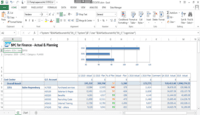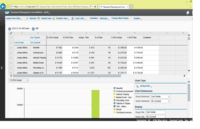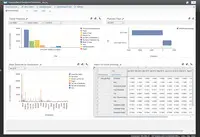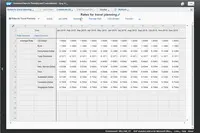SAP BPC (Business Planning and Consolidation)
Overview
What is SAP BPC (Business Planning and Consolidation)?
The SAP BPC software is designed to help users plan and achieve a faster, more accurate close. The SAP BPC software aims to help users spend more time growing their business and less time closing books. The vendor’s value proposition…
A financial reporting end-user perspective on SAP BPC.
Not so perfect but just does the job
SAP BPC
Easy Business Planner
Collaborative Budget Planning tool for the organization
Excellent planning tool for Sales Planning in SAP data sources
SAP BPC is great product for planning and consolidation with similar counterpart in cloud based offerings of SAP as SAC/Group Reporting
Not your Grandmother's Spreadsheet
SAP BPC Review
SAP BPC, the SAP product made easy for financial users
- Planning: With BPC we manage the financial budget across all …
Comprehensive Features
An excellent system for planning budgets and goals
SAP BPC
Awards
Products that are considered exceptional by their customers based on a variety of criteria win TrustRadius awards. Learn more about the types of TrustRadius awards to make the best purchase decision. More about TrustRadius Awards
Popular Features
- Management Reporting (36)8.080%
- Forecasting (36)7.878%
- Excel-based Reporting (35)7.777%
- Management reporting (36)7.676%
Reviewer Pros & Cons
Pricing
What is SAP BPC (Business Planning and Consolidation)?
The SAP BPC software is designed to help users plan and achieve a faster, more accurate close. The SAP BPC software aims to help users spend more time growing their business and less time closing books. The vendor’s value proposition is that their software delivers planning, budgeting,…
Entry-level set up fee?
- No setup fee
Offerings
- Free Trial
- Free/Freemium Version
- Premium Consulting/Integration Services
Would you like us to let the vendor know that you want pricing?
33 people also want pricing
Alternatives Pricing
What is Budgyt?
Budgyt is a platform made to simplify business budgeting. With built-in functions designed for data integrity, team collaboration, and scenario planning & analysis, Budgyt is presented as an optimized budgeting experience that rids users of complex, error-prone spreadsheets and the time-consuming…
What is PlanGuru?
PlanGuru is budgeting, forecasting and financial analytics software for SMB's, Nonprofits and the Accountants/ Advisors that work with them.
Features
Budgeting, Planning, and Forecasting
These activities are designed to assist with both data-driven operational, short-term planning and strategic long term planning
- 8.1Long-term financial planning(32) Ratings
3-5 year financial plan with cashflow.
- 8Financial budgeting(33) Ratings
Annual budget for revenue and operating expenses, headcount/compensation, capital expenses, projects, etc.
- 7.8Forecasting(36) Ratings
Combining actuals and budgets, rolling forecasts, driver-based models.
- 6.6Scenario modeling(32) Ratings
Financial or operational modeling of alternate future states and planning for each.
- 7.6Management reporting(36) Ratings
Budget vs. actual or forecast, P&L’s, performance over time, between products etc.
Consolidation and Close
Consolidation of data from multiple entities with currency management, reporting and audit trails.
- 8Financial data consolidation(33) Ratings
Consolidating data from several entities into a single statement using US GAAP, IFRS or other standards.
- 7.8Journal entries and reports(28) Ratings
Ability to enter journal entry adjustments and produce reports showing all journal entries for a specific period.
- 8.3Multi-currency management(25) Ratings
Ability to handle foreign currency conversions during consolidation.
- 7.8Intercompany Eliminations(28) Ratings
Matching and elimination of intercompany revenue, expenses, and balance sheet accounts.
- 6.9Minority Ownership(20) Ratings
Consolidate financials full or partial ownership of subsidiaries, equity pick-up.
- 7.9Local and consolidated reporting(30) Ratings
Ability to report against individual business entities and the consolidated umbrella entity.
- 8.2Detailed Audit Trails(27) Ratings
Tracing changes to data and processes that were run.
Financial Reporting and Compliance
Financial statements and regulatory filings
- 8.1Financial Statement Reporting(32) Ratings
Creation and production of balance sheets, income statements, cash flows, other schedules
- 8Management Reporting(36) Ratings
Tools facilitating creation of internal ad hoc or standard reports.
- 7.7Excel-based Reporting(35) Ratings
Ad hoc or formatted reports using MS Excel.
- 8Automated board and financial reporting(27) Ratings
Tools to help automate creation of regulatory reports such as SEC filings and board books.
Analytics and Reporting
Dashboards and scorecards for KPI monitoring and benchmarking
- 8.9Personalized dashboards(21) Ratings
Create custom dashboards and reports without the help of IT or administrators.
- 8.9Color-coded scorecards(19) Ratings
Track and analyze performances with interactive, color-coded balanced scorecards.
- 8.5KPIs(30) Ratings
Select from a library of more than 6,000 key performance indicators, and incorporate KPIs into your planning process.
- 8.7Cost and profitability analysis(26) Ratings
Cost and profitability analysis provides data for business decision making.
- 8.7Key Performance Indicator setting(23) Ratings
Ability to set key performance indicators for measuring progress towards goals.
- 7Benchmarking with external data(18) Ratings
CPI, daily exchange rates, industry KPIs. with scheduled data refreshes.
Integration
Ability to integrate with external applications.
- 7.1Flat file integration(32) Ratings
Integration of flat files like text documents and comma separated files
- 7.9Excel data integration(34) Ratings
Ability to integrate directly with Excel data.
- 6Direct links to 3rd-party data sources(22) Ratings
Integration with external applications like ERP, CRM, HCM
Product Details
- About
- Integrations
- Competitors
- Tech Details
- FAQs
What is SAP BPC (Business Planning and Consolidation)?
SAP BPC (Business Planning and Consolidation) Features
Budgeting, Planning, and Forecasting Features
- Supported: Long-term financial planning
- Supported: Financial budgeting
- Supported: Forecasting
- Supported: Scenario modeling
- Supported: Management reporting
Consolidation and Close Features
- Supported: Financial data consolidation
- Supported: Journal entries and reports
- Supported: Multi-currency management
- Supported: Intercompany Eliminations
- Supported: Minority Ownership
- Supported: Local and consolidated reporting
- Supported: Detailed Audit Trails
Financial Reporting and Compliance Features
- Supported: Financial Statement Reporting
- Supported: Management Reporting
- Supported: Excel-based Reporting
- Supported: Automated board and financial reporting
Analytics and Reporting Features
- Supported: Personalized dashboards
- Supported: Color-coded scorecards
- Supported: KPIs
- Supported: Cost and profitability analysis
- Supported: Key Performance Indicator setting
- Supported: Benchmarking with external data
Integration Features
- Supported: Flat file integration
- Supported: Excel data integration
- Supported: Direct links to 3rd-party data sources
SAP BPC (Business Planning and Consolidation) Screenshots
SAP BPC (Business Planning and Consolidation) Integrations
SAP BPC (Business Planning and Consolidation) Competitors
SAP BPC (Business Planning and Consolidation) Technical Details
| Deployment Types | On-premise |
|---|---|
| Operating Systems | Windows, Mac |
| Mobile Application | No |
Frequently Asked Questions
Comparisons
Compare with
Reviews and Ratings
(275)Attribute Ratings
- 7Likelihood to Renew1 rating
- 9Availability1 rating
- 7Performance1 rating
- 9Usability2 ratings
- 7Support Rating1 rating
- 9Online Training1 rating
- 9In-Person Training1 rating
- 8Implementation Rating1 rating
- 8Configurability1 rating
- 9Product Scalability1 rating
- 7.6Ease of integration36 ratings
- 8Vendor pre-sale1 rating
- 8Vendor post-sale1 rating
Reviews
(1-14 of 14)A financial reporting end-user perspective on SAP BPC.
- Integration with SAP actual results.
- Drilldown capabilities.
- Works well with Excel presentation.
- User interface not intuitive.
- Frequent system downtime/issues.
- No real-time update of entries.
Easy Business Planner
- Expense organization.
- Payment processing.
- Ease of use for all users.
- No external training needed for employees to understand use of SAP BPC.
- Better implementation of mobile app.
- Improvement of UI look, minor gripe.
- Integrated chat support for quick answers to issues.
Not your Grandmother's Spreadsheet
- Integrates with Excel.
- Has APIs that can connect to all different types of databases.
- Cube architecture allows for very big data
- The refresh time for our spreadsheets is maddeningly slow.
- It is not an intuitive product. I had to be taught how to unhide a tab in Excel because it doesn't let you unhide in the traditional way.
- It's very easy to wipe out mountains of data with a few keystrokes. There's no "undo" feature for this. I haven't done it, but others have. The data is backed up elsewhere, but you still have to reimport it and clean it up.
SAP BPC, the SAP product made easy for financial users
- Planning: With BPC we manage the financial budget across all the business units of the Company. We configured standard interfaces with the GL of our ERP (SAP R3) so we can easily measure the actuals vs. the annual plan. With the use of the EPM add-in for Excel, the financial users can create, consume and share reports.
- Consolidation: With the interfaces from the General Ledger to BPC it is easy to acquire information (balances) for reporting purposes. Also, we have configured business rules such as inter-company eliminations, adjustments or journals, so by executing a package from the EPM add in for Excel the consolidation team has been empowered and there is no IT involvement in the process.
- User friendly, with the use of the EPM add-in for Excel, business users can work in a familiar environment.
- SAP Analytics Cloud easy and native integration for dashboarding purposes.
- Can manage several business scenarios (versions): actuals, plan, forecast, etc.
- For Consolidation, there is a required dimension for auditing purposes (audit trail) so it is useful for internal and external audits.
- EPM add-in is only available for the Microsoft Windows Operating System.
- In order to open or refresh an inform, it is required to have the EPM add-in for MS Office already installed.
- Difficult to configure, ex. Script logic for ad-hoc adjustments.
SAP BPC is Dying
- BPC NW version can use the functionalities of SAP BW for ETL and data warehousing.
- Complex business requirements and logic can be built using SAP ABAP.
- Can be scaled and support huge volume of data using SAP HANA capabilities.
- SAP should focus on delivering one single product for planning, consolidation and budgeting needs rather than providing a large list of options to choose from.
- The product is not very user-friendly compared to other cloud competitors. There is a heavy dependency on IT teams.
- SAP BPC should come up a pure cloud option.
SAP BPC is less appropriate for organizations using Agile methodology. It is not suitable for organizations in a hyper-growth cycle as the installation and implementation is time-consuming. It will not work for organizations where the planning and budgeting needs keep changing frequently. The UI of SAP BPC is not very intuitive and very difficult to set up a dynamic dashboard for senior executives and officials of CxO.
- Allows for full integration of data to be analyzed in real time. Although we still load actuals on a delayed basis (2 business days after month end), when developing the budget, we not longer have to do a full loading process from a different application into BPC prior to being able to report and analyze the current budget status to prior budget versions or actuals.
- It is easy to learn basic report building. The hardest part is learning the available dimensions and the different possible combinations and their results, but that will also vary from company to company depending on the complexity of the industry.
- Being from a law firm, the system needed a lot of custom tailoring in order to fit our full needs (although many companies could say the same thing). Although the ability to highly customize the system to the company's needs is a positive, it frequently results in the system responding in unexplainable and unrepeatable ways which negatively impacts and slows the budget process. Because of the sporadic nature and variety of the issues, we are unable to repeat them on cue and therefore cannot nail down a solution.
SAP BPC, it’s OK
- Use of data sources allows easy identification of data origin. Ex: ECC, manual entry, management adjustment entry, ICC elimination, etc...
- Reporting is generally fast if best practices are used to avoid performance hits.
- There are a lot of BPC experts available to implement and provide training.
- BPC out of the box is a blank slate and requires system development to be implemented. Generally will need to hire consultants to build and train your organization.
- Many people are not familiar with multidimensional databases like BPC so there is a learning curve.
BPC Planning & Consolidation based on MS Review
- The Excel EPM functions are really good
- BPF functionality with a step by step guidance is a plus
- Intercompany Eliminations within BPC engine is very straightforward and easy to setup
- When a change is needed in the EPM reports it is not very flexible and needs IT intervention
- Performance sometimes is an issue when consolidating more then 20 entities specially at quarter end
- Script logic complex to handle and always needs BPC consultant when changes are requiered even if minimal - has very high costs
Dynamic Tool - BPC
- Accounting and finance users love this tool because reports are built using native Excel. If commands such as EPMCopyRange are utilized it can further the use of native Excel.
- Compared to BPC 7.5 our elimination and consolidation logic runs in a fraction of the time. Processes that would take multiple days can be accomplished within hours.
- Powerful and dynamic reports can be built to help business leaders make decisions and see trends.
- There is missing functionality on the ability to use the dynamic filter on apply a property when using the excluded members tab of the report editor. We are currently running SP30 BPC 10.1 and the ability existed in previous service packs. We now have to manually exclude some dimensions. We use member exclusions on our income statement tabs to help clean up the multiple total lines that appear when having two dimensions in the row running on member and descendants.
- In SP 30 and some of the later BPC 10.1 service packs, when a user searches for a dimension member, it displays the dimension member the number of times it shows up in another hierarchy. In previous service packs, when searching for a dimension, it would display the dimension member within the first hierarchy it appears in and then if the user clicked next, it would jump down to show the dimension member within the next hierarchy it is a part of.
- BPC is not able to handle to calculated member formulas in a report. For example, if a calculated profit center and a calculated datasource are used in a column of the report, BPC is not able to correctly compile and display the correct value for both calculated members.
SAP BPC answers the mail
- SAP BPC leverages Microsoft Excel well and provides an user interface that is easy to use for finance.
- SAP BPC integrates with our SAP R/3 to provide a holistic look at our project level data.
- SAP BPC provides flexibility that is needed in the A&D industry. We are able to customize functionalities for our business needs.
- I'd like to see BPC better handle large volumes of data. Our company plans at the contract level and often find ourselves struggling with data volume in terms of system performance.
- I'd like to see BPC have real-time data from our SAP R/3 system to facilitate a faster closing at month-end.
SAP BPC is well suited for companies with a large user base. Since BPC has a relatively familiar and easy user interface, it can be implemented across a large user group fairly quickly. The user interface is intuitive which facilitates an easier planning cycle.
Aerospace/Defense companies may need to customize SAP BPC to meet their business and customer needs. It would be ideal if SAP released a version of BPC specifically tailored towards the A&D industry.
Why BPC?
- Real time consolidation
- One Source of truth for Plan and Actual
- Powerful Predictive Analytics capabilities
- Multiple Architecture Solutions available for BPC could end up with wrong selection of the tool that may not be appropriate for the organization
- Need to procure additional software to compliment BPC (SAP Analytics for Cloud), the cost associated with additional license requirements
- Maturity and stability of the latest version
More appropriate when you have multiple ERP Systems
Also, for large companies who are acquiring new companies, easy way to get consolidated results of newly acquired companies in BPC
Less appropriate:
Organizations using single ERP and do not have complex product line verticals and large geographical presence
SAP Business Planning and Consolidation
- Financial Reporting. Improved use of big data.
- Consolidation at legal point of view
- Data integrity and process optimization
- Tax reporting
- Path navigation
- Flexibility
BPC for Financial Forecasting and Consolidations
- BPC has an Excel front end, which makes it especially friendly for Finance teams who like to work primarily in spreadsheets.
- BPC reporting in Excel is easy to learn and it is fast to execute ad hoc reports that pull updated values directly from the database. With minimal training, users can learn how to create and maintain their own reports which can quickly match up and compare forecast and actual values.
- BPC allows you to use the same system for both actual consolidations and the financial forecast process. This enables users to quickly combine forecast and actual values timely. It is not necessary to wait for transfers of data to/from other systems to combine forecast and actual values in the same report.
- BPC should come standard with web functionality that enables the same functionality as the EPM formulas.
- BPC script logic should run faster for logic which has to reference member properties. When script logic has such programming, it often runs slow as it goes through the dimension information.
Less Appropriate -- Resource Planning that meets the needs of both Finance for the financial forecast but also meets the needs of project planners which are trying to plan resources over the life of a project. It is difficult to meet the needs of both groups with BPC in a way that allows for resource actuals and the outlook to be combined.
Kinross Advanced Reporting System (KARS) aka SAP-BPC
Used to consolidate actuals and budget for +/- 250 legal entities for quarterly external reporting and monthly internal management reporting.
- Timeliness of close process i.e. ledgers are closed on work day 5 and consolidated financial statements are issued on work day 10 (non-quarter end months) and work day 15 (quarter end months).
- Consolidation completes in 12 minutes across 5 entity hierarchies.
- The Excel front-end report writer is very user friendly so users are able to create adhoc analysis reports quickly.
- From an administration point of view populating the 'Ownership' model is laborious across 5 Entity hierarchies and setting up data access profiles in Security is also tedious i.e. Security interface needs improvement.
- Investment elimination
- Fully automated cash flow
- Gold equivalent ratio by month, quarter & YTD
- Conversion of Imperial measurements to metric
- Fx translation
- Budgeting & forecasting
- Proportionate sub-consolidations








